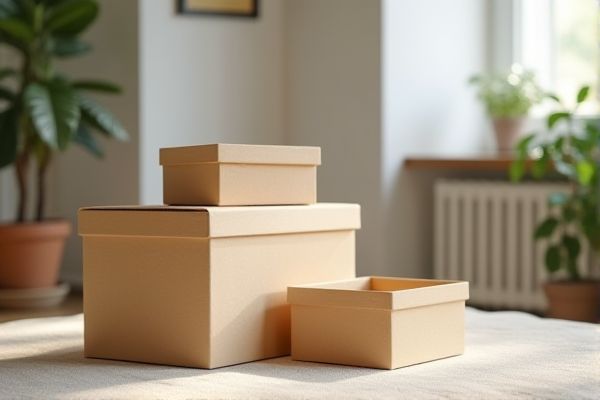
Stacking boxes are designed to securely sit on top of each other, maximizing vertical storage space, while nesting boxes fit inside one another to save space when not in use. Explore the differences and benefits of each type to decide which best suits Your storage needs.
Table of Comparison
| Feature | Stacking Box | Nesting Box |
|---|---|---|
| Description | Boxes designed to be placed securely one on top of another. | Boxes designed to fit inside one another for compact storage. |
| Space Efficiency | Optimizes vertical storage space. | Maximizes compactness when not in use. |
| Storage Use | Ideal for fixed storage and easy access. | Best for saving space during transport or storage. |
| Material Strength | Built to support weight of upper boxes. | May be lighter; designed to nest rather than support weight. |
| Typical Applications | Warehouses, retail display, inventory stacking. | Packaging, shipping, space-saving storage. |
| Durability | High durability for vertical load-bearing. | Moderate durability focused on nesting feature. |
Introduction to Stacking and Nesting Boxes
Stacking boxes are designed with flat, reinforced lids and uniform dimensions for stable vertical piling, optimizing warehouse space and simplifying inventory management. Nesting boxes feature tapered sides that allow one box to fit inside another when empty, reducing storage volume by up to 70% and facilitating easier transport. Both types enhance operational efficiency but cater to different space-saving and accessibility needs in logistics and manufacturing environments.
Definition: What Is a Stacking Box?
A stacking box is a container designed to be securely placed on top of another, enabling vertical organization and maximizing space efficiency in warehouses or storage areas. Unlike nesting boxes, stacking boxes maintain a rigid shape and often feature reinforced edges or interlocking lids to prevent slipping during stacking. Your choice between stacking and nesting boxes depends on whether you prioritize stability for piled storage or space-saving when boxes are empty.
Definition: What Is a Nesting Box?
A nesting box is a container designed to fit inside another, allowing efficient storage by occupying less space when not in use. Unlike stacking boxes, which are placed on top of each other to maximize vertical storage, nesting boxes emphasize compactness through internal placement. You can save space in your storage area by choosing nesting boxes that collapse or nest within one another.
Key Differences Between Stacking and Nesting Boxes
Stacking boxes are designed with flat tops and reinforced edges, allowing them to be securely placed on top of one another to maximize vertical storage space. Nesting boxes feature tapered sides that fit inside each other when empty, significantly reducing storage volume and saving space during transport. The key difference lies in their usage: stacking boxes optimize organized, space-efficient storage when full, while nesting boxes enable compact, efficient storage when empty.
Space Efficiency: Stacking vs Nesting
Stacking boxes maximize vertical space by allowing secure, stable piling, which is ideal for warehouse organization and efficient floor space use. Nesting boxes save even more space when empty by fitting one inside another, reducing storage volume by up to 70%, essential for return logistics and transport savings. Both methods enhance space efficiency, but nesting excels in minimizing storage footprint, while stacking optimizes usable storage during active use.
Material Durability and Load Capacity
Stacking boxes are typically made from heavy-duty plastic or metal, designed to withstand higher load capacities and frequent handling, making them ideal for industrial storage. Nesting boxes, constructed from lighter but durable materials, prioritize space-saving by fitting inside one another when empty, often supporting moderate loads rather than heavy weights. Material durability in stacking boxes ensures resistance to impact and wear, while nesting boxes balance durability with flexibility for compact storage.
Common Uses for Stacking Boxes
Stacking boxes are commonly used in warehouses and retail stores for efficient storage and organization of inventory, allowing for vertical space optimization. These boxes are designed with uniform sizes and reinforced corners to safely support heavy loads without crushing contents below. Industries such as logistics, manufacturing, and distribution frequently rely on stacking boxes for streamlined handling and transport of goods.
Common Uses for Nesting Boxes
Nesting boxes are commonly used in storage and organization to save space by fitting one box inside another, ideal for seasonal clothing, kitchenware, and craft supplies. They are favored in shipping industries for packaging items securely while minimizing volume during transport. Home and office environments utilize nesting boxes for decluttering and efficient use of limited storage areas.
Pros and Cons Comparison Table
Stacking boxes offer efficient vertical storage, saving floor space and easy access with uniform dimensions, but they can be less space-efficient when partially filled. Nesting boxes optimize storage by fitting inside each other when empty, reducing storage space significantly, though they require removing all contents before nesting and can be slower to access. The choice depends on specific needs: stacking boxes excel in quick, repetitive use with flat surfaces, while nesting boxes are ideal for minimizing empty storage volume.
How to Choose the Right Box for Your Needs
Choosing between stacking boxes and nesting boxes depends on your space efficiency and accessibility needs. Stacking boxes save floor space by allowing you to pile them vertically, ideal for maximizing storage in limited areas. Nesting boxes, which fit inside one another when empty, are perfect for reducing storage space when not in use, making them suitable for seasonal or infrequently accessed items.
 homyna.com
homyna.com